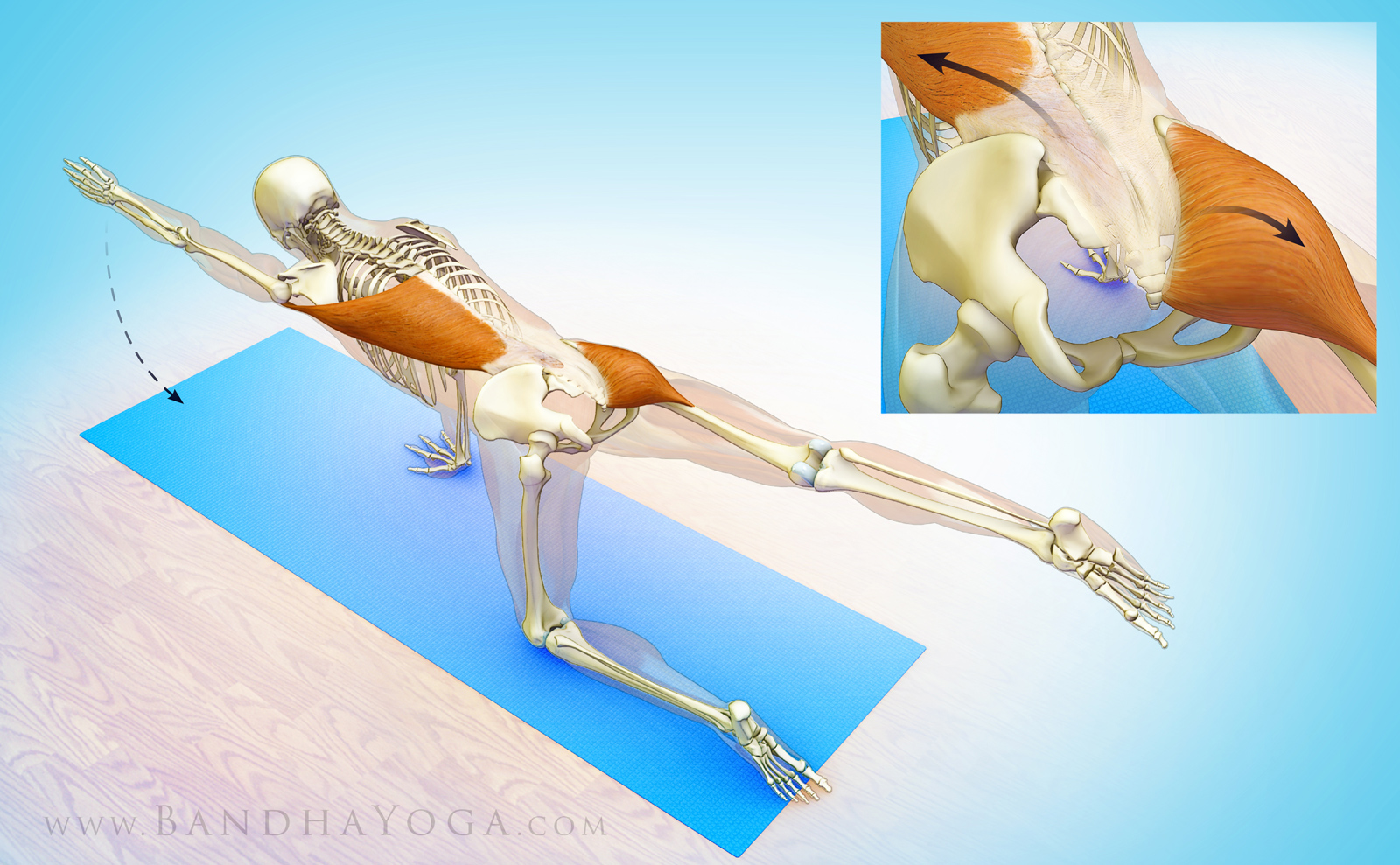Hello Friends,
Once you learn the individual muscles, then it’s time to look at how they function together during movement and in your asanas. Use your knowledge to develop cues to refine and deepen your poses. Groups of muscles, ligaments and fascia that function together are known as “subsystems”. In this post we examine the posterior oblique subsystem in Bird Dog pose.
The posterior oblique subsystem is comprised of the gluteus maximus on one side of the body and the latissimus dorsi on the other side, with the thoracolumbar fascia between (as shown in the inset illustration). These structures operate synergistically with other groups of muscles, ligaments and fascia, particularly during rotational movements such as a golf swing.
Figure 1 illustrates how the fibers of the gluteus maximus and opposite side latissimus dorsi run perpendicular to the sacroiliac joint. Co-contracting these two muscles can be used to tension the thoracolumbar fascia, thus stabilizing the sacroiliac joint. Click here to learn more about the thoracolumbar fascia and its important role in core stability.
Bird Dog is an excellent pose for strengthening the core and engaging the posterior oblique subsystem. A good cue for activating the latissimus dorsi muscle in this pose is to straighten the arm forward and then imagine pushing down with the hand against an immoveable object (as shown with the dotted arrow). Alternatively, imagine pulling down on a rope with the forward hand. Combine this isometric contraction of the lats with engaging the gluts on the side of the lifted leg to augment the stabilizing effect on the SI joint.
Click here to check our our previous post, "Connect Your Cuff to Your Core in Forearm Plank" and see how this subsystem works in plank pose. With this in mind, what other poses can be used to activate the posterior oblique myofascial subsystem? Place your answer in the comment section below…
Once you learn the individual muscles, then it’s time to look at how they function together during movement and in your asanas. Use your knowledge to develop cues to refine and deepen your poses. Groups of muscles, ligaments and fascia that function together are known as “subsystems”. In this post we examine the posterior oblique subsystem in Bird Dog pose.
The posterior oblique subsystem is comprised of the gluteus maximus on one side of the body and the latissimus dorsi on the other side, with the thoracolumbar fascia between (as shown in the inset illustration). These structures operate synergistically with other groups of muscles, ligaments and fascia, particularly during rotational movements such as a golf swing.
Figure 1 illustrates how the fibers of the gluteus maximus and opposite side latissimus dorsi run perpendicular to the sacroiliac joint. Co-contracting these two muscles can be used to tension the thoracolumbar fascia, thus stabilizing the sacroiliac joint. Click here to learn more about the thoracolumbar fascia and its important role in core stability.
Bird Dog is an excellent pose for strengthening the core and engaging the posterior oblique subsystem. A good cue for activating the latissimus dorsi muscle in this pose is to straighten the arm forward and then imagine pushing down with the hand against an immoveable object (as shown with the dotted arrow). Alternatively, imagine pulling down on a rope with the forward hand. Combine this isometric contraction of the lats with engaging the gluts on the side of the lifted leg to augment the stabilizing effect on the SI joint.
| Image may be NSFW. Clik here to view.  |
| Figure 1: The posterior oblique subsystem and sacroiliac joint in Bird Dog Pose. |
Click here to check our our previous post, "Connect Your Cuff to Your Core in Forearm Plank" and see how this subsystem works in plank pose. With this in mind, what other poses can be used to activate the posterior oblique myofascial subsystem? Place your answer in the comment section below…
Thanks for stopping by--I hope you're enjoying learning about biomechanical concepts like the myofascial subsystems and how they work in your poses. Stay tuned for the next post when I'll go over the hamstring connection to the pelvis and lumbar. Click here to browse through the Bandha Yoga book series on anatomy, biomechanics and physiology for yoga.
All the Best,
Ray Long, MD
